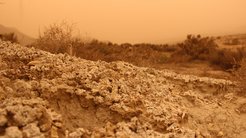Dust catchers: Biological crusts influence the climate
A surface layer of bacteria, fungi and lichen amongst others reduces the amount of dust stirred up into the atmosphere
When bacteria, fungi, mosses, lichens and algae combine on dry land, they form so-called biological soil crusts. These cover about twelve percent of the total global land surface, and up to one third of the surface in dry areas. Biological soil crusts play an important role in consolidating soils, making them more stable and less likely to be stirred up by the wind. Since dust particles in the atmosphere have an impact on the climate, soil crusts fulfil an important function in several respects. An international team of researchers around biologist Bettina Weber of the University of Graz and research associate of the Max Planck Institute for Chemistry provide, for the first time, comprehensive facts and figures on the importance of biological soil crusts for the regional and global dust cycle, both under current and future conditions.

The largest areas with biological crusts are in Africa, the Middle East and Asia, Australia and the Midwest of the USA. However, they can be found worldwide wherever temperature, rainfall and soil conditions are suitable. "We estimate that biological soil crusts reduce global atmospheric dust emissions by about 60 percent," Weber says. However, by 2070, the authors expect biocrust cover to decrease due to climate change and intensification of land use, with declines of 25 to 40 percent depending on the scenario. As a result, more dust will enter the atmosphere – with various effects.
"On the one hand, dust has climatic effects, as water condenses or ice crystals form on the dust particles, which influences precipitation patterns," Weber explains. Dust also has a cooling effect in the lower atmosphere by reducing solar radiation. "According to our calculations, this corresponds to about half of the cooling effect of aerosols released by humans – for example, through the burning of fossil fuels and biomass," adds the researcher who worked until 2019 as a group leader at the Max Planck Institute for Chemistry.
Dust reduces solar radiation and provides nutrients
On the other hand, dust transports nutrients that, if blown away, are lost from the local site, and can have a fertilizing effect in the target area. In barren areas in particular, the nutrient input can cause damage that ultimately displaces the original vegetation. Sand also carries microorganisms that colonize newly formed and existing habitats. "In the process, pathogens can spread and harm plants, animals or humans," Weber explains as another connection. Thus, the loss of soil crusts poses a potential risk to climate, environment and health.
The researchers obtained their results by combining measurement data on biological soil crusts with a global climate model to calculate the current influence of biocrusts and simulate future scenarios. They recommend that the essential function of biological soil crusts should be taken into account in future modelling of global change, in measures to mitigate climate change, and in the design of adaptation strategies.
„The results of our study show how closely the evolution of life and climate are connected to each other,“ adds Ulrich Pöschl, director at the Max Planck Institute for Chemistry and co-author of the new study. „The scientific understanding of these and similar connections is also important for the future development and conception of the Anthropocene, i.e., the current geological era shaped by the globally pervasive and rapidly increasing human influence on planet Earth.“












